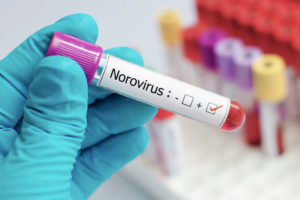Outbreaks peak between the months of November and April. It can strike anyone of any age. It hits children under age 5 and the elderly the hardest
By Eva Briggs
 It’s that time of year again. No, I don’t mean holiday season. I mean norovirus season.
It’s that time of year again. No, I don’t mean holiday season. I mean norovirus season.
This nasty little virus is the most common cause of acute vomiting an d diarrhea in the United States. It’s the leading cause of foodborne illness. Outbreaks peak between the months of November and April.
Norovirus can strike anyone of any age. It hits children under age 5 and the elderly the hardest. By age 5 years, one out of six will receive outpatient treatment for norovirus. One out of 14 kids will visit an emergency room. And one out of 278 will be admitted to the hospital. Between healthcare costs and lost productivity, norovirus costs about $2 billion per year.
Norovirus illness causes diarrhea, vomiting, and abdominal pain. It only takes 12 to 48 hours after exposure for symptoms to start. The illness tends to be intense but brief, and most people recover in one to three days. There’s no vaccine to prevent it. And there’s no specific treatment, just rest, fluids and nausea medicines.
This tiny virus can infect people who are exposed to as few as 20 viral particles. The viral particles can survive on surfaces for as long as 42 days. A tablespoon of vomit contains 15 million viruses, and a tablespoon of diarrhea holds up to 75 billion! Here are some tips gleaned from a New York Times article about how to reduce the chance of spread. After I read the article to my husband, he said it might actually be easier to destroy the house and start over next time someone brings norovirus home.
• Step 1, keep your hands clean. This means soap and water, particularly scrubbing fingertips and nail beds. Hand sanitizers don’t work.
• Step 2, quarantine. If your house has more than one bathroom, designate one as the sick bathroom for sick household members only. The sick people need to stay home and in a separate part of the house. Healthy people must stay away from the sick bathroom and the sick people. Unless, of course, you are the parent or caretaker of someone too young or too sick to take care of themselves.
• Step 3, clean contaminated surfaces. This means the toilet, its handle, the sink, the doorknob and anything else that a sick person or their fluids might have touched. Close the toilet lid before flushing so that virus particles don’t aerosolize and spread. Then pour in 1/2 cup of bleach and flush again.
The best household product to kill norovirus is bleach. Mix half to one cup of bleach in a gallon of water and use that to wipe down surfaces. Let the bleach solution sit on the surface for at least five minutes (10 minutes is best) before wiping it off. The virus particles don’t die immediately upon contact with bleach. You can also use healthcare grade bleach wipes, which you will probably need to order from the internet. Unfortunately, cleaners and wipes sold for household use are not powerful enough to kill norovirus. Even if the label states they kill 99% of germs on contact.
It’s probably a good idea to wear disposable gloves, goggles and a facemask, especially if you are cleaning up after a family member who didn’t make it to the toilet in time. To clean a mess from the floor, cover the fluid with paper towels or sprinkle kitty litter or sawdust on it, then scoop into a plastic bag. Close with a twist tie and dispose. Scrub the area with soap and water. Then disinfect it with bleach as described above.
It turns out that there are actually researchers who study vomit and fecal cleanup strategies. And — this is the line that made my husband think he might just move to a new house next time someone gets sick — to really be effective you have to clean everything within a 25-foot radius. Walls. Table legs. Any other surface. Disinfecting rugs and upholstered furniture is problematic because bleach may damage the color. A steam cleaner for five minutes at 170°F could do the trick. Or spray with hydrogen peroxide after testing an inconspicuous area to determine that the item won’t be damaged.
Clothing and linens should be washed on the hot or sanitize setting. Use bleach if possible. Designating specific plates, utensils and cups for sick family members is a good idea. Some dishwashers don’t kill all norovirus.
People with type B or AB blood are more resistant to norovirus. That’s of no consolation to my son who has type O blood. His recent bout with norovirus — which required a trip to the urgent care for IV fluids — inspired this article. This is one time where I’m glad he lives hundreds of miles away.
So, stay safe out there. Consider stocking up on appropriate cleaning supplies now, especially if you have small children who might bring this plague and pestilence into your household.
Eva Briggs is a medical doctor who works at two urgent care centers in the Syracuse region.

